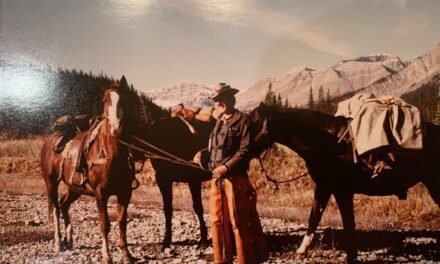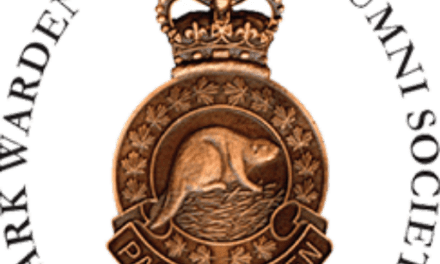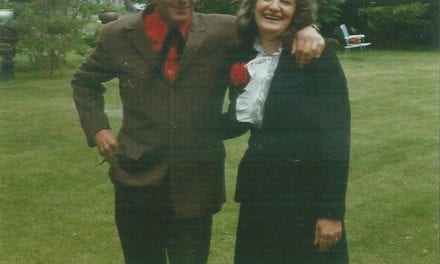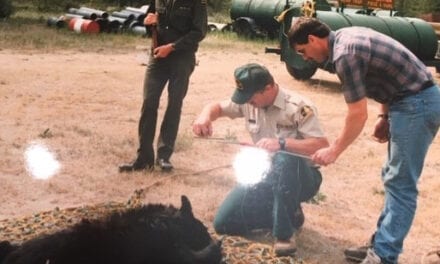As background, during the summer before (1979), between Terry Skjonsberg at Lake Louise and me and Monte in Banff townsite we’d captured, some of them were recaptures, and performed over 100 bear immobilizations. Wardens had known all along that we had a garbage (people) problem, not a bear problem in National Parks…. for more than two decades.
Terry, Ron Le Blanc and I all remained connected to the University of Montana through Dr. Charles Jonkel and the Border Grizzly Project, which spanned all of the western US and Canada. We continued to attend annual meetings in the Flathead valley, for many years in order to keep up with grizzly and wolf conservation efforts and offer our own contributions.
In 1981 being given, at long last, the green light to resolve the well-known garbage problem in Banff National Park (using our law enforcement powers, if necessary), by Superintendent Paul Lange, following the report of his expert Blue Ribbon Panel in the wake of the 1980 (Banff) townsite bear attacks.
Working with Dr. Stephen Herrero and Banff National Park Engineer Bob Cross to create blueprints for mandatory bear-proof enclosures for all garbage containers and grease barrels, as well as designing the bear-proof lid still used on Neufeld bins (of all sizes) now installed in all National Park’s, and across the continent.
Knowing that we had been successful, at least temporarily, in solving the bear-human problem because10 years later, hardly anybody remembered even how to immobilize a bear, they were such infrequent occurrences. That was the nub of the problem.
Riding horseback while herding a large group of bison, watching the lead cow spin on her heals, and realizing that the bison are now suddenly herding Wardens, but in the opposite direction.
Being a member of Ian Pengelly’s Fire Command Team, as Fire Behaviour Analyst/ Plans Chief and working alongside Byron Irons, Ken Schroeder, and Ron Zinc during numerous mobilizations to other parks and regions in the National Park system.
Law enforcement was not my specialty, but I’m proud to say that I was able to lay charges on two occasions that led to the maximum fine being levied by the court against the violators, both involved wildlife (bear) infractions.
Working with fire managers from across western Canada ~1995 to gather and prioritize a multi-year list of Green Plan research projects, which were funded and completed over 4 years in support of advancing the re-introduction of wildland fire into National Park ecosystems.
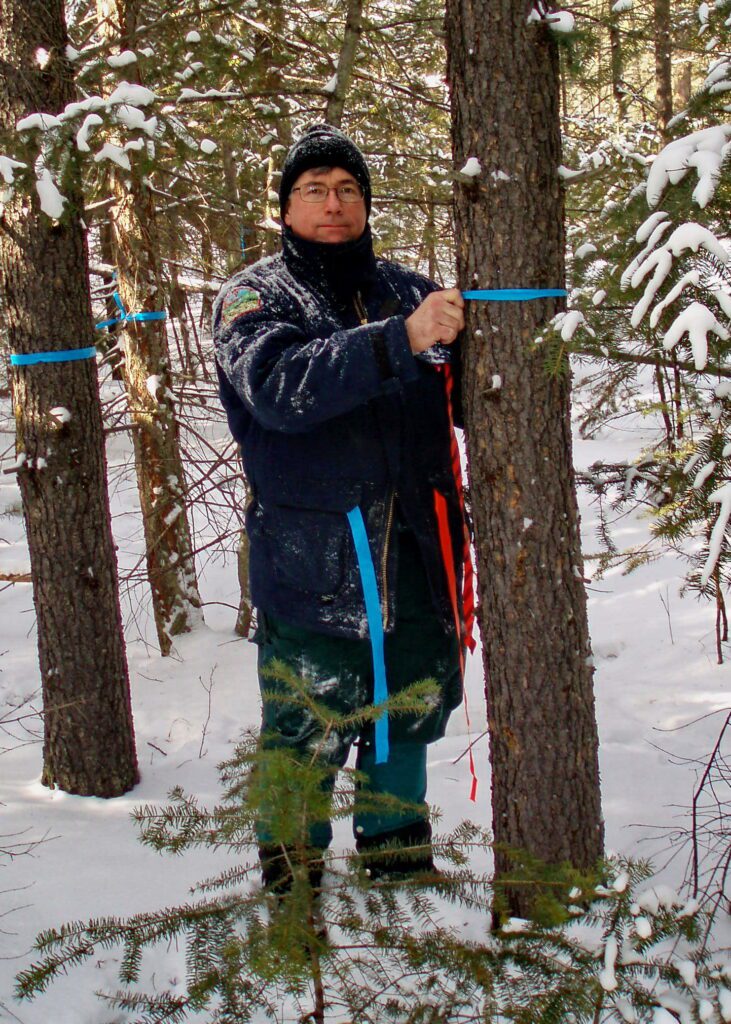
Brokering consensus, in 1993 among Chief Park Warden’s and Regional Directors from Prairie, Northern and Mountain Parks that joint resources be combined into a single Fire Management Service Centre, then establishing and operationalizing that office in Calgary until 1996.
Developing and implementing some of the essential support systems necessary to operationalize the ground-breaking work by Cliff White to modernize wildland fire management in National Parks.
Being able to hire permanent and seasonal staff, build effective teams and help mentor young people as they launched successful careers in vegetation, fire, park and natural resource management; and being able to remain in touch as long-time family friends.
Almost daily 20 – 30km foot patrols and explorations in the Egypt Lake Warden District, and long-distance fall boundary patrols on horseback during every kind of weather on the eastern slopes.
Toasting completion of a successful planned-ignition prescribed burn with colleagues in Banff, Elk Island, Riding Mountain and Jasper.
Partnering with researchers from the Canadian Forest Service and Foothills Research Institute to initiate research related to fire history, natural disturbance and fire effects on vegetation & wildlife.
As an extension of my park duties, being supported by many National Park managers to play a lead role in creating the Canadian FireSmart® program, to reduce the risk of losses from wildland-urban fire.
Collaborating and experimenting with Jasper National Park communication specialists (Janet Breau and Caroline Duchoslav) and residents of the Lake Edith Cottage Assoc. and townsite to create the (now) nation-wide FireSmart Canada Neighbourhood Recognition Program®.
During my first winter at Banff, feeling cocky about my fitness and ski-touring skills, until a historic weekend involving 48 hours of non-stop avalanche rescues (and fatalities), when I found myself sucking wind in the dark, as I tried to keep up with wily veteran Wardens twice my age.
Doubling up to continue work full-time in Jasper while also taking a full course load at the University of Calgary and writing my M.Sc. thesis during two consecutive winter semesters; and probably being the first student to take calls from a forestry contractor in the statistics lab.
Being part of a 3-person delegation to help evaluate US National Park fire management policy following the 1988 Yellowstone controversy; and one of two Canadian participants during a 12-day tour across South Africa to view and evaluate their national wildfire protection and prescribed burning programs.
Maintaining an active working partnership with the Municipality of Jasper Fire Chief (and friend), Greg Van Tighem, from 1997 until 2022, for the purpose of planning and implementing a comprehensive wildland-urban fire strategy to facilitate the restoration of fire to the Athabasca valley; we called it the FireSmart – ForestWise program.
Can you tell me about any rescue/wildlife stories that stick out in your memory?
I have already told or hinted at a few, but here is another significant story that helped me to understand our responsibilities as Park Wardens.
During my first summer as a seasonal Warden in Banff National Park, posted at Saskatchewan Crossing, Banff Dispatch called one summer evening and asked me to confirm the presence of a vehicle owned by 2 climbers, overdue on an attempt to climb the north face of Mount Alberta. It was still there, and one of the largest and most complex rescues on record was triggered.
A helicopter was sent from Valemount early the next morning, and picked up one of the climbers, wandering on the mountaintop. His companion had been injured and had been lashed to the face, mid-mountain. The weather socked in heavily, thus eliminating potential for a simple heli-sling rescue. So, it was decided that an enormously long double cable-rescue attempt, of several thousand feet, would be mounted from the top, simultaneous with a climbing party which would start from the base. Both were extremely technical operations, and very dangerous. Immediately, a call went out the best of our best Warden climbers from every point on the compass. They quickly converged, some of them driving all night, at the Columbia icefields.
I was assigned to manage the communications and dispatch out of the Icefields Chalet (rescue headquarters). This was a challenge in 1979, because the radio repeater network in the parks had some big gaps. I had several hand-held radios on my desk (different channels for rescuers at the top, bottom and in between), intermittent and scratch base radio connections with the Banff Warden Office, and an actual physical phone link with the Jasper Warden Office (wires strung on trees all the way to the Icefields).
It was a tense situation, (the) going was slow and dangerous due to loose rock and active avalanching. Thankfully, perhaps it was day #2, Garry Forman was able to spot a gap in the clouds and pendulum-in a Warden on long-line below his Jet Ranger to grab the injured climber, as both teams continued their valiant vertical efforts.
This was my first exposure to mountain rescue, and to the incredible competency and coolness of Park Wardens working under extreme conditions. I sat at rescue base, and had a birds-eye view of the operation while performing my duties. I watched, listened and learned from the masters (e.g., the Israelsons, Clair and Gerry, Hans Fuhr, Willi Pfisterer, Tim Auger, Davidson, Peter Fuhrmann and others were all there, as well as Chief Wardens and Assistant Chief Park Wardens. And, everyone came home safe.
How did the Warden Service change over the years?
It seems to me that I was hired at the perfect time! Although the Warden Service had been “centralized” by moving Wardens previously stationed and living year-round in the backcountry into town to work out of offices, many of those who worked under the old system, and had the true knowledge of the land that can only be gained by being on the land, were still present and active. Their first-hand knowledge, experiences, observations, skills, perspectives and logic were still there (in the coffee room) to be shared and discussed, if you took the time to ask. Fortunately, I think many of us baby-Wardens, as Moe Vroom openly called us, did. We worked together with WWII veterans, European alpinists who became expert horsemen, and the sons and daughters of pioneers who had earned “home-grown” Ph.D.’s, or had returned to college to obtain diplomas in biological sciences. Being among the first wave of Wardens with university degrees gave us some advantages, but the biggest benefit was being able to work together, to build on the strong foundations of existing knowledge and practical operations.
Visitor pressures, shifting budgets and management styles resulted in enormous and continual changes over a relatively short span of decades. Changes which were often, but not always, for the best. I cite the adoption of “Parks as a business” as one example of the latter. Regardless, that rapid pace of change, states of knowledge and the challenges faced by Wardens in natural resource management (and all functions) has continued ever since.
Regarding change within the Warden Service, it’s been commonplace for bureaucrats to criticize the Warden Service for being “slow to adapt” or “resistant to change”. While that criticism was opportune, I think it was largely unfair and quite contrary to reality. From my perspective, the Warden Service has adapted itself continuously throughout its century-long existence. That is, until it was disbanded and re-constituted into separate entities; one for law enforcement and another, more stove-piped and fragmented model, for other core functions, around 2007.
No matter what organization or job you’re in, there’s a certain amount of griping. But the point I’d like to make here is that I cannot imagine or know of any organization that was more adaptable, and more willing and accepting of radical changes. When I think about the wranglers, range-riders and ex-military people (you know, like, Earl Skjonsberg, Terry’s dad) and the huge and lasting contributions they made, it gives an opposite perspective. A lot of those guys that I worked with, had been a backcountry stations for years and years, and now they’re in town. That didn’t change their dedication to Parks, or how hard they worked towards the things that needed to be done. They put that behind them, and kept their shoulders to the wheel. What’s more, they showed patience with “young whippersnappers” with university degrees like me. It was a great and productive mix of people. Collectively, us youngsters drew upon their knowledge and experience and our elders grew to accept our schooling. In the end, I think it all melded into better bear management, better fire management, better park management. The Warden Service lead in lots of ways and in many different functional fields because of that. I personally worked along with, many government agencies, especially in the fire business, that admired and respected the Warden Service for that ability.
What about the Warden Service was important to you?
The traditional, historic structure and function of the Warden Service was a good and practical idea, that worked well for preserving and restoring the ecological integrity of National Park ecosystems while promoting appreciation and appropriate use by Canadians. The root concepts of National Parks (as per Harkin and Lopoukhine) is still sound, even more relevant but increasingly challenging today due to climate warming. As a result, I believe that eventually the organizational model will evolve away from ultra-specialization and back towards a multi-disciplinary team of individual who are versatile and more able to be present on the land, as well as managing it.
It is just my opinion, but I think small parks are kind of the reservoir that retains more aspects of the traditional “jack-of-all-trades Warden Service. They don’t have enough staff to do otherwise. Warden functions in the big parks seem to have been all segregated and broken up. Hopefully, small parks with their residual multi-functioning staff will be the “seed bed” for future re-organizations that promote Warden generalists. I believe that will be the long-term “lesson learned” but it will likely have to be forgotten and “re-discovered” first.
In the meantime, I believe my energy is well-spent in volunteering to work with and expand the National Park Warden Alumni Society, and to create opportunities to help keep our friendships, memories and fond awareness of the past alive.
Are there any legendary characters or stories associated with the Warden Service that you can share? Is there anyone from the Service that stands out in your mind?
Well, one character that stands out in my mind is a fellow named of Jimmy Syme. He was the Warden Service Officer at the Regional Office in Calgary office when I was in my teens. After that camping trip I mentioned, when I met that backcountry Warden in Banff, I realized Parks had an office down there. I stumbled into his office one day to ask about the job. He gave me the low-down, but an incident while I was in his office actually showed me about the job. Initially, when I sat in front of him, his intensity made me feel the primal “fight or flight” instinct, and I was tending towards running. While we were talking his phone rang. He picks it up and says, “yeah, yeah, okay. Okay, was anybody hurt? Okay, how many horses were killed”. He hung up and continued as if nothing had happened, then excused himself politely to “make a few calls”. Years later I learned there had been a serious accident involving Wardens and a horse trailer on the road to the Ya Ha Tinda, and the ranch was one of his many responsibilities. If that didn’t demonstrate coolness under pressure, nothing would. That encounter gave me just huge respect for that man and for the things that wardens did. Years later, Jimmy sat on my first Warden interview panel. Knowing a bit about him made me a bit more at ease. Also, it didn’t hurt that I was the first one able to answer his “ringer” of a question of the day: “Have you ever heard of a snow water sculpin?” I had encountered this rare species of fish during my Yoho forest mapping days, where a small creek flows into Emerald Lake. Jimmy’s eyes just lit up, and I think I impressed him.
Andy Anderson was another. Banff was such a political place always, and Andy the Chief Park Warden had to deal with all that, from as far away as Ottawa. I’m sure I don’t know half of it, but he fought those battles with such good humor, always with a “tee-hee” laugh. I have to have respect for him holding out for values and principles the way they did.
Another influential role model of integrity and ability was Rick (Eric) Langshaw. Rick was working at Lake Louise, in charge of bears, when I was at Saskatchewan Crossing. I saw him handle some tough management and life and death rescue situations. I’ll always admire Rick and, boy, there couldn’t be a more lighthearted and fun guy to be around.
The irrepressible, intelligent and energetic Cliff White is another unforgettable friend and character. We’ve been colleagues and good friends since our first meeting on a trail near Saskatchewan crossing about 1977 (he was counting tree rings of course), through years of promoting good fire management and then to teaching courses together for the US Forest Service in Arizona recently.
Similarly, I can’t finish up without mentioning Peter Achuff, Jack Willman and all of the all-star seasonal staff I’ve been blessed to work with over the year. What a privilege it has been!
Is there anything about the Warden Service as you knew it that you would want future generations to know?
Already covered – skip this Question.
